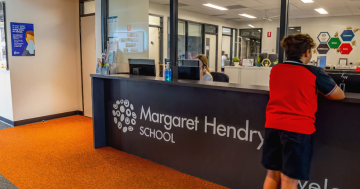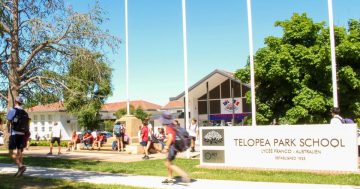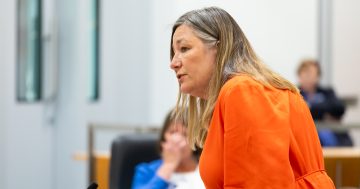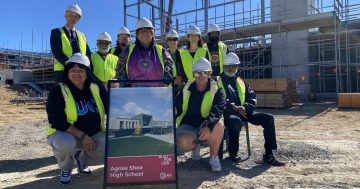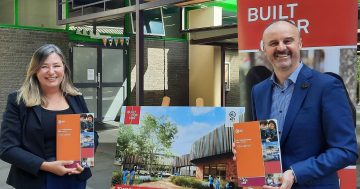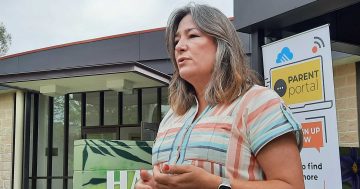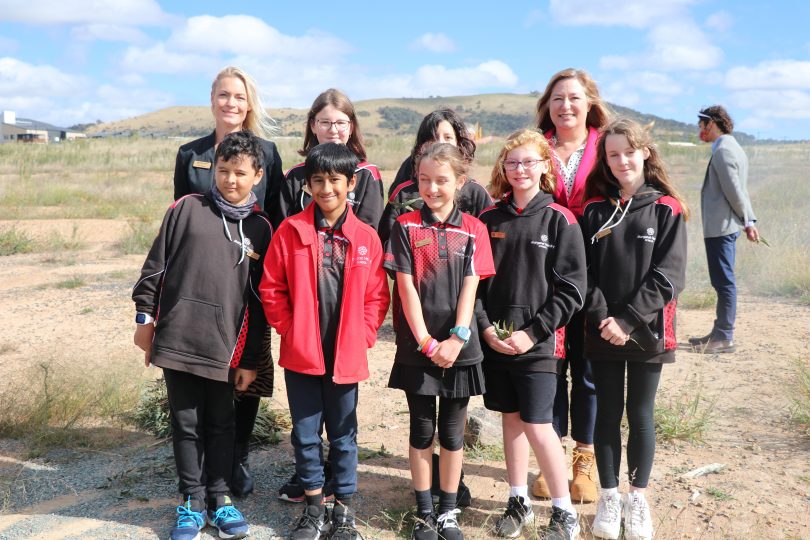
Margaret Hendry School principal Kate Woods and Minister for Education Yvette Berry with students from the school. Photo: ACT Government.
As $118 million of school construction and expansion work gets underway in Gungahlin, Minister for Education Yvette Berry has been forced to defend the government’s plans.
This is despite relatively new schools, like the four-year-old Margaret Hendry School in Taylor, already being expanded to host an additional 600 students by the 2023 school year.
The school is projected to grow to more than 1200 students by 2030.
Next door, the government is also building an 800-place high school, which is projected to open at the start of the 2024 school year.
Hindmarsh Construction had been selected as the lead contractor for both projects.
But the students who graduate from Margaret Hendry School in year 6 at the end of this school year will need to attend other schools – probably Amaroo or Gold Creek high schools for at least one year while this school is constructed.
Minister for Education Yvette Berry was asked yesterday whether it would have been better to build a larger high school to take students directly from the next-door school.
However, the minister said she was confident in the capacity calculations and said the high school would be bigger than most of Canberra’s secondary schools, which have around 600 places.
Ms Berry said Kenny High School in Gungahlin’s east, which had been due to open in 2023 but is now more likely to accept students from 2025, would also take students.
She also noted that priority enrolment areas (PEAs) could be adjusted to manage demand.
“There are a number of priority enrolment areas which will take capacity for students at this school, including the new Kenny High School,” she said.
Ms Berry said that while not all public primary school students would attend public high schools, more Canberrans were choosing to remain in the public system for secondary school.
“We have very, very high numbers of students who want to attend public schools and that increases every year … so we make sure there are schools available for those young people,” she explained.
According to the ACT Education Directorate’s latest annual report, several changes to PEAs had been made in 2021 for the 2022 school year. Most of these adjustments took place in the Inner North, Molonglo and Gungahlin.
Ms Berry said she was as “confident as she [could] be in these uncertain times” in the construction timelines for both the Margaret Hendry expansion and the Taylor construction.
The relatively new but rapidly growing Gungahlin region, home to Throsby, Australia’s fastest-growing suburb, is not the only place where schools are feeling the pinch as population growth outstrips enrolment estimates.
A Legislative Assembly inquiry into the management of ACT school infrastructure was told last month about schools being forced to use specialist spaces and ‘seas’ of demountable classrooms for teaching as school infrastructure struggled to keep up with population growth and demand.
In response, the government said Majura and North Ainslie primary schools in Canberra’s inner-north would be permanently expanded to keep up with growing enrolments and capacity pressures.
The modernisation of Campbell Primary School is also underway.
In 2020-21, an additional 650 places were provided at public schools thanks to the installation of demountable classrooms. Most of these places were created in schools in Canberra’s inner north and inner south.
Parents in the inner north, in particular, have long called for a new school to be built to cope with future demand resulting from population increases related to in-fill development projects.
Education directorate officials said at a recent hearing that it was hoped the construction of new schools in surrounding NSW towns would help ease some of the pressure on Canberra’s schools.
The Directorate also works with the ANU School of Demography to project where and how future population growth would occur and impact future school enrolment.
Officials said schools are visited at least every two years so their total capacity can be assessed.













